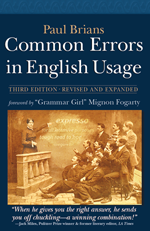What follows is not a comprehensive guide to the many uses of commas, but a quick tour of the most common errors involving them.
The first thing to note is that the comma often marks a brief pause in the flow of a sentence, and helpfully marks off one phrase from another. If you write “I plan to see Shirley and Fred will go shopping while we visit” your readers are naturally going to think the announced visit will be to both Shirley and Fred until the second half surprises them into realizing that Fred is not involved in this visit at all. A simple comma makes everything clear: “I plan to see Shirley, and Fred will go shopping while we visit.” People who read and write little have trouble with commas if they deal with English primarily as a spoken language, where emphasis and rhythm mark out phrases. It takes a conscious effort to translate the rhythm of a sentence into writing using punctuation.
Not many people other than creative writers have the occasion to write dialogue, but it is surprising how few understand that introductory words and phrases have to be separated from the main body of speech in direct address: “Well, what did you think of that?” “Good evening, Mr. Nightingale.”
Commas often help set off interrupting matter within sentences. The proper term for this sort of word or phrase is “parenthetical.” There are three ways to handle parenthetical matter. For asides sharply interrupting the flow of the sentence (think of your own examples) use parentheses. For many other kinds of fairly strong interjections, dashes—if you know how to type them properly—work best. Milder interruptions, like this, are nicely set off with commas. Many writers don’t realize that they are setting off a phrase, so they begin with the first comma but omit the second, which should conclude the parenthetical matter. Check for this sort of thing in your proofreading.
A standard use for commas is to separate the items in a series: “cats, dogs, and gerbils.” Authorities differ as to whether that final comma before the “and” is required. Follow the style recommended by your teacher, editor, or boss when you have to please them; but if you are on your own, I suggest you use the final comma. It often removes ambiguities.
A different kind of series has to do with a string of adjectives modifying a single noun: “He was a tall, strong, handsome, but stupid man.” But when the adjective becomes an adverb modifying another adjective instead of the noun, then no comma is used: “He was wearing a garish bright green tie.” A simple test: if you could logically insert “and” between the adjectives in a series like this, you need commas.
English teachers refer to sentences where clauses requiring some stronger punctuation are instead lightly pasted together with a comma as “comma splices.” Here’s an example: “He brought her a dozen roses, he had forgotten she was allergic to them.” In this sentence the reader needs to be brought up sharply and reoriented mid-sentence with a semicolon; a comma is too weak to do the trick. Here’s a worse example of a comma splice: “It was a beautiful day outside, she remembered just in time to grab the coffee mug.” There is no obvious logical connection between the two parts of this sentence. They don’t belong in the same sentence at all. The comma should be a period, with the rest being turned into a separate sentence.
Some writers insert commas seemingly at random: “The unabridged dictionary, was used mainly to press flowers.” When you’re not certain a comma is required, read your sentence aloud. If it doesn’t seem natural to insert a slight pause or hesitation at the point marked by the comma, it should probably be omitted.
See also colons/semicolons and hyphens & dashes.
Hear Paul Brians discuss commas on his Common Errors in English Podcast.
BUY THE BOOK!
